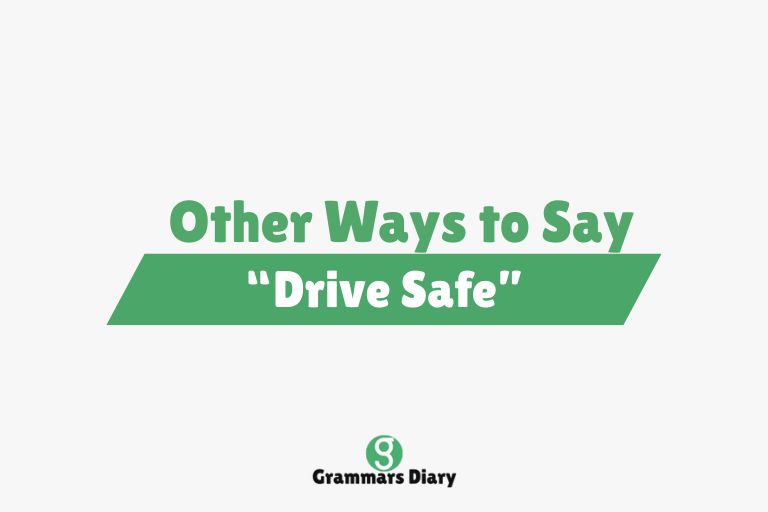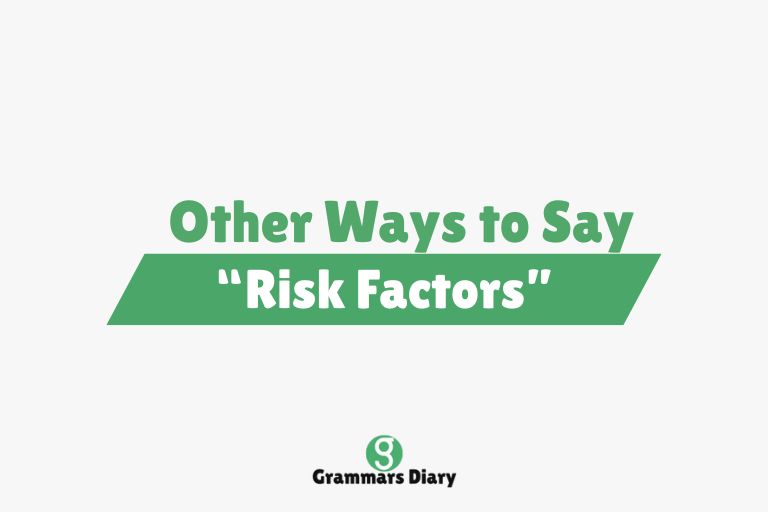20 Other Ways to Say “Drive Safe”

“Drive safe” is a phrase we often use when someone is heading out on the road, whether it’s a short commute, a cross-country road trip, or just a quick run to the store — and while it’s simple, caring, and familiar, it’s also one of those expressions that can begin to feel a bit repetitive over time.
But don’t worry — if you’re looking to express that same sense of care, caution, and goodwill with a little more creativity or emotional depth, there are plenty of alternative phrases you can use that still communicate the same heartfelt sentiment.
This article explores twenty thoughtful, expressive, and context-friendly ways to say “Drive safe,” giving you the flexibility to tailor your words based on how close you are to the person, the tone you want to strike, and the occasion.
20 Other Ways to Say “Drive Safe”
1. Take care on the road
Example: “It’s getting dark — take care on the road.”
Meaning: A gentle reminder to be cautious while driving, especially when conditions may not be ideal.
Usage: Works well in both casual and semi-formal settings, often used when expressing general concern or kindness.
2. Get home in one piece
Example: “Let me know when you’re back — get home in one piece.”
Meaning: Lighthearted but caring; implies a safe journey free from harm or accident.
Usage: Perfect for friends or close colleagues when you want to blend humor with genuine concern.
3. Watch out for traffic
Example: “Rush hour’s starting — watch out for traffic, okay?”
Meaning: Encourages awareness of potential driving hazards like congestion or reckless drivers.
Usage: Informal and practical, ideal for everyday use when the road conditions might be challenging.
4. Travel safe
Example: “Text me when you land — travel safe.”
Meaning: A broader version of “drive safe,” often used for longer journeys or trips involving various modes of transport.
Usage: Great for messages before road trips, vacations, or business travel.
5. Keep your eyes on the road
Example: “No texting while driving — keep your eyes on the road.”
Meaning: A direct reminder to stay focused and avoid distractions while driving.
Usage: Casual, practical, and firm — great for loved ones or teens learning to drive.
6. Stay alert out there
Example: “It’s raining pretty hard, so stay alert out there.”
Meaning: Emphasizes staying mentally engaged and aware of surroundings while on the road.
Usage: Works well when driving conditions are risky or unpredictable.
7. Don’t rush
Example: “There’s no need to hurry — don’t rush and get there safe.”
Meaning: A reminder to drive at a safe pace, not to speed or take unnecessary risks.
Usage: Warm and reassuring, good for anyone who tends to drive fast or is in a hurry.
8. Have a smooth ride
Example: “Hope traffic isn’t bad — have a smooth ride.”
Meaning: A friendly wish for an easy, hassle-free journey without disruptions.
Usage: Suitable for coworkers, friends, or anyone heading into their daily commute.
9. Let me know when you arrive
Example: “Drive safe and let me know when you arrive.”
Meaning: Adds an extra layer of care by requesting a check-in after travel.
Usage: Thoughtful and responsible, often used between close friends, partners, or family.
10. Safe travels
Example: “Enjoy the drive — safe travels!”
Meaning: A polite, all-purpose way to express your hope for someone’s safety and comfort while traveling.
Usage: Universally acceptable and often used in professional, social, or formal messages.
11. Stay safe behind the wheel
Example: “I know you’re tired, so please stay safe behind the wheel.”
Meaning: Emphasizes the driver’s responsibility while handling a vehicle, with a hint of concern for their alertness and wellbeing.
Usage: Best used when the driver may be fatigued or driving under less-than-ideal conditions, often among family or close friends.
12. Hope the roads treat you well
Example: “It’s a long drive — hope the roads treat you well.”
Meaning: A poetic and slightly whimsical way of wishing someone an easy and uneventful journey.
Usage: Informal, expressive, and friendly — great for texts or parting words among close connections.
13. Mind the weather
Example: “It looks like snow later, so mind the weather out there.”
Meaning: A thoughtful way to remind someone to be cautious if weather conditions may affect driving safety.
Usage: Common during seasonal weather changes or sudden downpours, especially when you want to show extra care.
14. Don’t forget to buckle up
Example: “Alright, don’t forget to buckle up — love you.”
Meaning: A safety reminder packaged with affection and care.
Usage: Particularly useful when speaking to children, teens, or loved ones heading out.
15. Take it slow
Example: “No rush, just take it slow and get there safe.”
Meaning: A calming, soothing reminder that safety is more important than speed.
Usage: Works well for anxious or emotional goodbyes, often from parents, spouses, or close friends.
16. Be cautious out there
Example: “The roads have been icy lately — be cautious out there.”
Meaning: Encourages extra vigilance due to known dangers or past incidents.
Usage: Thoughtful and measured, great for older drivers or winter conditions.
17. Don’t take any chances
Example: “If it feels risky, don’t take any chances — call me if needed.”
Meaning: A more serious reminder that driving safely sometimes means knowing when to stop or delay.
Usage: Best for emotionally supportive conversations or dangerous travel conditions.
18. Take the safe route
Example: “Even if it’s longer, take the safe route home tonight.”
Meaning: Suggests prioritizing safety over speed or convenience.
Usage: Encouraging for young drivers or loved ones unfamiliar with an area.
19. Stay in touch while on the road
Example: “Just shoot me a message when you take a break — stay in touch while on the road.”
Meaning: A gentle way of staying connected during a trip while subtly checking in on safety.
Usage: Ideal for longer drives or travel across distances.
20. Text me when you’re there
Example: “Drive safe and text me when you’re there, okay?”
Meaning: A common and caring request to receive confirmation of someone’s safe arrival.
Usage: Frequently used among partners, close friends, and family members.
When to Use Different “Drive Safe” Alternatives
In Casual Conversations
In friendly, informal situations — like chatting with coworkers, classmates, or neighbors — options such as “Have a smooth ride,” “Travel safe,” or “Watch out for traffic” strike a natural and polite tone while still expressing goodwill and caution without sounding too intense or overly emotional.
In Professional or Formal Settings
In a work environment or when speaking to colleagues or clients, choosing neutral but respectful options like “Safe travels,” “Take care on the road,” or “Stay safe behind the wheel” is best, as these convey genuine concern while maintaining an appropriate level of professionalism.
In Emotional or Close Relationships
When speaking to loved ones — whether it’s your partner, child, or best friend — more expressive and emotional options like “Let me know when you arrive,” “Don’t forget to buckle up,” or “Take it slow” show warmth, affection, and an added layer of personal connection that simple phrases sometimes lack.
Conclusion
While “Drive safe” remains a thoughtful and kind way to show you care, expanding your vocabulary with alternative phrases can make your sentiments feel even more sincere, nuanced, or appropriate for the moment — whether you’re saying goodbye to someone you love, checking in with a friend on the road, or sending a client off after a meeting. By using words that better fit the relationship, the situation, or the tone, you can turn a simple farewell into a meaningful expression of concern, attention, and humanity.
If you’re looking to further build your communication toolkit, exploring synonym resources like Thesaurus.com can help you uncover even more expressive language to match your intentions.
FAQs
What does “Drive safe” mean?
It’s a common phrase used to wish someone a safe journey while they are driving, expressing care and concern for their wellbeing on the road.
Is “Drive safe” formal or informal?
“Drive safe” is informal and conversational; in formal or professional contexts, alternatives like “Safe travels” or “Take care on the road” are more appropriate.
Can “Drive safe” and “Travel safe” be used interchangeably?
Generally, yes — although “Travel safe” is broader and can apply to any kind of travel, not just driving.
What’s the difference between “Take it slow” and “Don’t rush”?
Both mean to avoid speeding or hurrying, but “Take it slow” sounds more calming and gentle, while “Don’t rush” might sound more direct or commanding, depending on tone.






